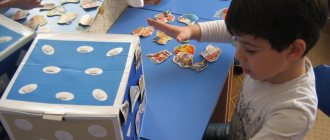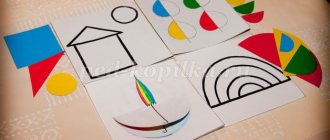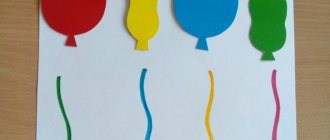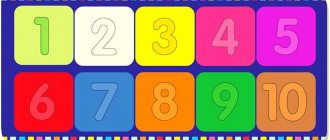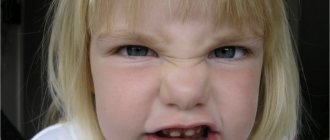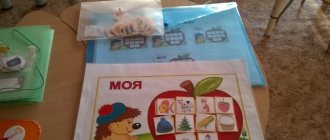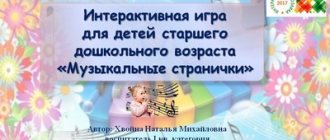Didactic games for developing the active vocabulary of children 4-5 years old
Municipal autonomous preschool educational institution
“Baikalovsky kindergarten No. 1 “Teremok”
Didactic games
to develop an active vocabulary
children 4-5 years old
Baikalovo 2017
Collection of “Didactic games for the development of the active vocabulary of children 4-5 years old”
/. Guidelines.
Baikalovo, 2017 Compiled by: Skomorokhova T.M., teacher
The collection presents didactic games aimed at developing an active vocabulary for children 4-5 years old.
This collection of games is intended for speech therapists, preschool teachers, as well as for parents interested in the problem of developing children's active vocabulary.
Content
| Explanatory note | 4 |
| Section 1. Games for developing noun vocabulary | 5 |
| Section 2. Games to develop verb vocabulary | 9 |
| Section 3. Games to develop adjective vocabulary | 11 |
| Section 4. Games to develop adverb vocabulary | 15 |
| Bibliography | 30 |
Introduction
Vocabulary work in kindergarten is the systematic expansion of children’s active vocabulary using words that are unfamiliar or difficult for them. It is known that the expansion of the vocabulary of preschoolers occurs simultaneously with their familiarization with the surrounding reality, with the development of a correct attitude towards the environment. A rich vocabulary is a sign of well-developed speech and an indicator of a high level of mental development. Timely development of vocabulary is one of the most important factors in preparing for school education.
The development of vocabulary affects the harmonious development of the child. The emotional development of preschool children and the child’s understanding of the emotional state of other people also depend on the degree of assimilation of verbal designations of emotions, emotional states and their external expression.
nspect of didactic b. M,,Work on speech development occupies an important place in the system of education and training of preschool children. It is carried out not only in direct educational activities, but also in regime processes.
In the middle group, intensive work is provided to deepen the child’s knowledge of subjects. His passive and active vocabulary is enriched by words - names of parts and details of objects, their qualities and properties (color, shape, size, surface features, etc.), as well as words characterizing spatial and temporal relationships.
The collection of games was developed taking into account the psychological characteristics of children of middle preschool age and is aimed at developing an active vocabulary.
SECTION 1. GAMES FOR THE DEVELOPMENT OF NOUN DICTIONARY.
Game No. 1.
“Who wants a treat?”
The purpose of this game is to develop the ability to use difficult forms of nouns in speech.
Didactic material: pictures depicting a bear, geese, chickens, swans, horses, wolves, foxes, lynxes, monkeys, kangaroos, giraffes, elephants. Progress of the game: Children are offered the task of distributing gifts among the animals and telling whom which gift is suitable.
The children were asked questions: Who needs honey? Who needs grain? Who wants meat? Who wants fruit?
Game No. 2.
“Name the parts of an object”
The goal of this game is to enrich the vocabulary of nouns, develop the ability to relate an object and its parts.
Didactic material: pictures of a house, truck, tree, bird, etc.
Progress of the game: In the first version of the game, the children were given the task of looking at the pictures one by one and naming the parts of the depicted object.
In the second version of the game, each child received a card with a picture. It was necessary to look at the drawing, name it and tell what parts the depicted object consists of.
Game No. 3. “Throw the ball and say the words”
The purpose of this game is to expand vocabulary through the use of generalizing words, develop attention and memory, and the ability to relate generic and specific concepts.
Didactic material: ball.
Progress of the game: In the first version, I named the general concept of vegetables, fruits, berries, trees, etc. and threw the ball to each child in turn. The children, returning the ball, named objects related to this general concept.
In the first version of the game, I named a general concept and threw the ball to each child in turn. The children, returning the ball, named objects related to this general concept. In the second version of the game, I named species concepts to the children and also threw a ball to each child. The children, returning the ball, named generalizing words.
Game No. 4. “ Who was who or what was what”
Goal: expanding the vocabulary of nouns and knowledge about the environment.
Progress of the game: The teacher asks the children questions. Who or what was the chicken before? (egg), horse (foal), frog (tadpole), butterfly (caterpillar), boots (leather), shirt (cloth), fish (egg), wardrobe (board), bread (flour), bicycle (iron), sweater (wool), etc.?
Game No. 5. “Half a word is yours”
Goal: to form a vocabulary of nouns.
Didactic material: ball.
How to play: The participants sit in a circle and throw the ball to each other. At the same time, the thrower loudly says half of a word; the one who catches must name his other half. For example, a locomotive, a telephone. Any player can throw the ball. You need to answer quickly. For each mistake or delay, the player is eliminated from the game.
Its conditions can be complicated. The leader gives (says) half a word to each child sitting in a circle. And everyone must continue the second half. Can't - penalty point. The presenter begins to say his half of the word, for example, “tele...” Children
Game No. 6 with the ball “Animals and their young”.
Goal: forming a vocabulary of nouns, consolidating the names of baby animals in children’s speech, consolidating word formation skills, developing dexterity, attention, and memory.
Didactic material: ball.
Progress of the game. When throwing the ball to the child, the adult names an animal, and the child, returning the ball to the speech therapist, names the baby of this animal. Basic movements: throwing the ball with a hit on the floor, throwing the ball; rolling the ball while sitting on the carpet. The words are arranged into three groups according to the method of their formation. The third group requires memorizing the names of the cubs.
Group 1. The tiger has ..., the lion - ..., the elephant - ..., the deer - ..., the elk - ..., the fox - .
Group 2. A bear has a bear cub, a camel has a camel cub, a wolf has a cub, a hare has a cub, a rabbit has a bunny cub, a squirrel has a cub, a cow has a calf, a horse has a foal, a pig has a piglet, a sheep - a lamb, a hen has a chick, a dog has a puppy.
Group 3. Tiger cub - lion cub - elephant calf - deer calf - fox calf, etc.
Game No. 7. “Say kindly” Catch a small ball and caress it with a word.
Goal: strengthening the ability to form nouns using diminutive suffixes, developing dexterity and speed of reaction.
Didactic material: ball.
Progress of the game. The speech therapist, throwing the ball to the child, calls the first word (for example, ball), and the child, returning the ball, the speech therapist; names the second word (ball). Words can be grouped according to similar endings. Table - table, key - key. A hat is a slipper, a squirrel is a squirrel. A book is a little book, a spoon is a spoon. The head is the head, the picture is the picture. Soap - soap, mirror - mirror. A doll is a doll, a beet is a beet. Braid - braid, water - water. Beetle - beetle, oak - oak. Cherry - cherry, tower - turret. A dress is a dress, an armchair is an armchair. A feather is a feather, glass is a piece of glass.
Game No. 8. “One
-
a lot”
Goal: to consolidate various types of endings of nouns in children’s speech.
Didactic material: ball.
Progress of the game. The speech therapist throws the ball to the children, calling singular nouns. Children throw the ball back, naming plural nouns. You can throw the ball with hits on the floor, roll the ball while sitting on the carpet. Examples: Table - tables, yard - courtyards, nose - noses, mountain - mountains, hole - holes, bridge - bridges, house - houses, eye - eyes, meadow - meadows, city - cities, wire - wires, cold - cold, day - days, stump - stumps, sleep - dreams, forehead - foreheads, ear - ears, chair - chairs, stake - stakes, leaf - leaves, feather - feathers, wing - wings, tree - trees, sock - socks, stocking - stockings, piece - pieces, circle - circles, friend - friends, jump - jumping, duckling - ducklings, gosling - goslings, chicken - chickens, tiger cub - tiger cubs, baby elephant - baby elephants.
Game No. 9. “Fun Score”
Goal: to consolidate the agreement of nouns with numerals in children’s speech. Development of dexterity and reaction speed.
Didactic material: ball.
Progress of the game: The speech therapist or presenter throws the ball to the child and pronounces a combination of a noun with the numeral “one”, and the child, returning the ball, in response calls the same noun, but in combination with the numeral “five” (or “six”, “seven”, "eight"…). First, it is better to name combinations based on the similarity of the endings of nouns. Examples: one table - five tables, one elephant - five elephants, one closet - five closets, one goose - five geese, one swan - five swans, one crane - five cranes, one nut - five nuts, one T-shirt - five T-shirts, one cone - five cones, one duckling - five ducklings, one gosling - five goslings, one chicken - five chickens, one hare - five hares, one finger - five fingers, one dress - five dresses, one hat - five hats, one glove - five gloves, one can - five cans, one mitten - five mittens, one button - five buttons, one soap dish - five soap dishes, one hat - five hats, one book - five books, one candy - five candies. Option “And I have” The presenter throws the ball and says: “I have one table.” The child, throwing the ball back, replies: “And I have five tables.”
Game No. 10. “It happens - it doesn’t happen.”
Goal: expansion and consolidation of the child’s active vocabulary, development of logical thinking.
Didactic material: ball.
Progress of the game. The players stand in a circle. The presenter calls the seasons. For example: "Summer". And then, throwing the ball to one of the children, he names a natural phenomenon. For example: “Ice drift”. The child who caught the ball must say whether this happens or not. The game goes in circles. Whoever makes a mistake leaves the game. Variants of natural phenomena and seasonal changes: frost, ice drift, drops, leaf fall, blizzard, frost, rain, snow, hail, thunderstorm, etc. Complication. Children give complete answers, explaining the possibility or impossibility of this or that natural phenomenon at a given time of year.
Game No. 11. “Who will be who?”
Goal: development of thinking, imagination, reaction speed, expansion of the vocabulary of nouns.
Didactic material: ball.
Progress of the game. The presenter, throwing the ball to the children, asks questions: “Who (what) will it be - an egg, a chicken, a boy, an acorn, a seed, an egg, a caterpillar, flour, iron, brick, fabric, a student, a sick person, a weak person,” etc. Children , throwing the ball back, can give several answers. For example: “An egg can produce a chick, a crocodile, a turtle, a snake, and even a scrambled egg.”
SECTION 2. GAMES TO DEVELOP VERB DICTIONARY.
Game No. 1. “Who talks like that?”
The purpose of this is to expand the verbal vocabulary and develop reaction speed.
Didactic material: ball.
Progress of the game. In the first version, I threw a ball to each child in turn and named an animal. For example: cow, tiger, snake, mosquito, dog, wolf, duck, pig, etc. Children, returning the ball, had to answer correctly how this or that animal gives a voice. For example: moos, growls, hisses, squeaks, barks, howls, quacks, grunts, etc. In the second version of the game, I threw the ball to the child and asked: “Who is growling?”, “Who is mooing?”, “Who is barking?” , "Who's crowing?" etc. Children had to name the appropriate animals.
Game No. 2. “Give me a word.”
The goal of this game is to develop verbal vocabulary, thinking, and reaction speed.
Didactic material: ball.
Progress of the game. In this game, children stood in a circle. During the game, I threw the ball to each child in turn and asked questions: The crow croaks, and the magpie? An owl flies, but a rabbit? The cow eats hay, but what about the fox? The mole digs holes, but what about the magpie? The rooster crows, and the chicken? The frog croaks, and the horse? The children, returning the ball, answered: The magpie is chirping. Etc.
Game No. 3. “What happens in nature?”
The goal of the game is to reinforce the use of verbs in speech and the agreement of words in a sentence.
Didactic material: ball.
Progress of the game. In this game, I threw the ball to each child in turn and asked questions on the topic “Spring.” For example: Children, what does the sun do in spring? The children answered: it shines, it warms. What are the streams doing? The children answered: they are running, murmuring. What does snow do? It's getting dark and melting. What are the birds doing? They fly in, build nests, sing songs. What does Kapel do? It's ringing. What is the bear doing? Wakes up, leaves the den, etc.
Game No. 4. "Make a proposal"
Goal: development of attention, speed of mental operations.
Didactic material: ball.
Progress of the game. The speech therapist throws the ball to one of the children while uttering inconsistent words (for example: “Girl play”). The child, having caught the ball, pronounces a sentence from these words (“The girl is playing”) and throws the ball back to the speech therapist.
Game No. 5. “Who moves how?”
Goal: enrichment of children’s verbal vocabulary, development of thinking, attention, dexterity.
Didactic material: ball.
Progress of the game. The speech therapist, throwing the ball to the child, asks a question; the child, returning the ball to the speech therapist, must answer the question asked. The game is played with throwing the ball in different ways. Speech therapist: How do birds move? What about butterflies, flies, dragonflies, mosquitoes, midges? How do fish move? What about dolphins, whales, walruses, sharks? What are snakes doing? What about caterpillars and worms? How do grasshoppers move? What about frogs, toads, fleas, hares?
Game No. 6. “Who does what?”
Goal: consolidating children’s knowledge about the profession, enriching children’s verbal dictionary, developing attention and dexterity.
Didactic material: ball.
Progress of the game. Option 1. When throwing or rolling a ball to a child, the speech therapist names a profession, and the child, returning the ball to the speech therapist, must name a verb denoting what the person in the named profession does. Speech therapist: builder. Children: builds; cook (cooks (cooks); porter (carries); draftsman (draws); worker (works); cleaner (cleans); artist (draws), etc.
Option 2. The speech therapist names the verb, and the child names the profession (sells - seller).
Game No. 6. “Who can make these movements?”
Goal: activation of children’s verbal dictionary, development of imagination, memory, dexterity.
Didactic material: ball.
Progress of the game. The speech therapist, throwing the ball to the child, names the verb, and the child, returning the ball to the speech therapist, names the noun that matches the named verb. Speech therapist: Going. Children Man, animal, train, steamship, rain, snow, hail, time, road; Runs (Man, animal, stream, time); Flies (Bird, butterfly, dragonfly, fly, beetle, mosquito, plane, helicopter, rocket, satellite, time, telegram); Swims (Fish, whale, dolphin, swan, boat, ship, man, cloud).
Game No. 7. “What can this item do?”
Goal: enrichment of children’s verbal vocabulary, development of thinking.
Progress of the game. An adult names an object and asks the child what this object can do? For example, a broom can sweep, a shovel can dig, etc.
Examples of words: sun, rain, night, spoon, swing, cat, bird, plane, etc. Don’t forget to ask with each answer: “What else does the sun do, it doesn’t just shine?” Let the child choose as many words as possible that denote the action.
Game No. 8. “Who wants to become who?”
Goal: to teach children to use difficult verb forms in speech.
Didactic material: plot pictures depicting labor actions.
Playing move. Question to the child: What are the boys doing? (The boys want to make a model of an airplane) What do they want to become? (They want to become pilots). Children are asked to come up with a sentence with the word want or want.
SECTION 3.
GAMES FOR DEVELOPMENT OF ADJECTIVE DICTIONARY.
Game No. 1. “What is it made of?”
The goal of the game is to consolidate the use of relative adjectives and methods of their formation in children's speech.
Didactic material: ball.
Before playing the game, it was first explained to the child that if an object is made of wood, then it is wooden, and if it is made of iron, then it is iron, etc. Then work was carried out on the pictures, after which this topic was reinforced in the ball game .
Progress of the game. I, throwing the ball to the child, said: “Boots made of leather,” and the child, returning the ball, answered: leather. Then she threw the ball to another child, said: “Mittens made of fur,” and the child, returning the ball, answered: fur, etc. A basin made of copper. (Copper), Plush bear (Teddy), Woolen mittens (Wool), Glass glass (glass), crystal vase (Crystal), etc. Then I asked the children to make sentences with these phrases. For example: Masha has a teddy bear.
Game No. 2. “Catch and throw - name the colors”
The goal of the game is to develop the ability to select nouns for adjectives denoting color, to expand the vocabulary of adjectives, to consolidate the names of primary colors, and to develop children’s imagination.
Didactic material: ball.
Progress of the game. When throwing the ball to the child, she named an adjective denoting color, and the child, returning the ball, named a noun that matches this adjective. For example: red - poppy, fire, flag, orange - orange, carrot, dawn; yellow - chicken, sun, turnip; green - cucumber, grass, forest; blue - sky, ice, forget-me-nots; blue - bell, sea, ink; purple - plum, lilac, twilight, etc.
Game No. 3. "Whose head?"
The goal of the game is to expand children's vocabulary through the use of possessive adjectives. The game was played after discussing the pictures. The correct use of all these various endings in speech was achieved through repeated repetition of words in game situations.
Didactic material: ball.
Progress of the game. When throwing the ball to one of the children, she said: “A crow has a head...”, and the child, throwing the ball back, finishes: “... a crow,” etc. Examples: a lynx has a lynx’s head, a fish has a fish’s head, a cat has a fish’s head. cat's, magpie's - magpie's, hare's - hare's, rabbit's - rabbit's, camel's - camel's, horse's - horse's, duck's - duck's. for a swan - swan, for a deer - fawn, for a fox - fox, for a dog - canine, for a bird - bird's, for a sheep - sheep's, for a squirrel - squirrel, for a bear - bear's, for a tiger - tiger's, for a chicken - chicken, the dove has the dove's, the eagle has the eagle's. As a complication, the children were asked to make sentences with these adjectives.
Game No. 4. "Hot Cold"
Goal: formation of a dictionary of adjectives, consolidation in the child’s mind and dictionary of the opposite characteristics of objects or antonym words.
Methodical instructions. The game is carried out after preliminary work with pictures and the child’s assimilation of words such as “same”, “similar”, “different” (“different”), “opposite”. From the pictures: The river is wide, but the stream is narrow. The bear is big, and the bear cub is small. The grandfather is old, and the young man is young.
Progress of the game. The speech therapist, throwing the ball to the child, pronounces one adjective, and the child, returning the ball to the speech therapist, names another - with the opposite meaning. Speech therapist: Hot - Children: Cold (Good - Bad; Smart - Stupid; Cheerful - Sad; Sharp - Dumb; Smooth - Rough; Light - Heavy; Deep - Shallow; Light - Dark; Kind - Evil; Joyful - Sad; Fast - Slow; Frequent - Rare; Soft - hard; Clear - cloudy; High - low)
Complication. You can invite children to add a noun. For example: A sharp knife. Clear day. Deep lake.
Game No. 5. “What is round?”
Goal: expanding children's vocabulary through adjectives, developing imagination, memory, and dexterity.
Didactic material: ball.
Progress of the game. Throwing the ball to children in various ways, the speech therapist asks a question, which the child, having caught the ball, must answer, and then return the ball to the speech therapist. The speech therapist, in turn, passes the ball to the next child, waiting for an answer from him.
1. What is round? (Ball, ball, wheel, sun, moon, apple, cherry...)
2. What is long? (Road, river, rope, thread, tape, cord...)
3. What is tall? (Mountain, tree, man, hundred, house, closet...)
4. What is green? (Grass, trees, bushes, grasshoppers, dress...)
5. What is cold? (Water, snow, ice, dew, frost, stone, night...)
6. What is smooth? (Glass, mirror, stone, apple...)
7. What is sweet? (Sugar, sweets, pies, cakes, waffles...)
8. What is wool? (Dress, sweater, mittens, gloves, hat...)
9. What is prickly? (Hedgehog, rose, cactus, needles, spruce wire...)
10. What is spicy? (Knife, awl, glass, scissors, dagger, blade...)
11. What is easy? (Fluff, feather, cotton wool, snowflake).
12. What is deep? (Ditch, ditch, ravine, well, river, stream...)
Game No. 6. "Guess the toy"
Goal: to enrich the subject dictionary, the dictionary of adjectives, to develop the ability to find an object, focusing on its signs and actions.
Didactic material: toys hare, fox, duckling, dog.
Progress of the game. The speech therapist shows the child 3-4 toys, he names them. You must immediately teach how to correctly name an object: “This is... (hare, fox, duckling).” The speech therapist talks about each toy, naming external signs: “This is a soft toy. She's gray. The tail is short and the ears are long. He loves carrots and jumps smartly.” Other toys are described in a similar way, the child names them. Invite the child to describe one of the toys.
Game No. 7. "Tell me which one"
Goal: to form a vocabulary of adjectives, learn to identify and name the characteristics of an object.
Didactic material: Fruits in a box.
Progress of the game. The adult takes objects out of the box, names them (“This is a pear”), and the child names the signs (“It’s yellow, soft, tasty.” “This is a tomato.” - “It’s red, round, ripe, juicy.” “This is a cucumber.” - “It’s... oblong, green, crispy”).
Game No. 8. "Compare the Beasts"
Goal: to form a vocabulary of adjectives, teach to compare different animals, highlighting opposite characteristics.
The speech therapist suggests looking at a bear and a mouse.
- The bear is big, and the mouse... (small). Also, what kind of Mishka... (fat, thick-footed, club-footed)? And what kind of mouse... (small, grey, fast, dexterous)? What Mishka loves... (honey, raspberries), and the mouse loves... (cheese, crackers).
- Mishka’s paws are thick, and the mouse’s... (thin). The bear screams in a loud, rough voice, and the mouse... (in a thin voice). Who has the longest tail? The mouse has a long tail, and Mishka... (short).
On the basis of clarity, work is carried out and familiarization with polysemantic words (chair leg - table leg - mushroom leg; handle on a bag - handle on an umbrella - handle on a cup; sewing needle - needle on a hedgehog on its back - needle on a Christmas tree).
Game No. 9.
“What is he like?”
Goal: to form a vocabulary of adjectives, to teach the child to actively describe the characteristics of objects.
Progress of the game. Ask your child to bring everything square that he finds in the house. For example: a book, a box, a cube, a board from the kitchen, a CD, a TV, etc. And then ask him to describe all the objects that are united by one characteristic - square. Let him find and explain the similarities and differences of objects, as well as their purpose.
SECTION 4.
GAMES FOR DEVELOPING THE DICTIONARY OF ADVERBS.
Game No. 1. “Where is who?”
Purpose of the game: to form a vocabulary of adverbs.
Didactic material: board, cardboard pictures of grandfather, house, fence, 2 trees, bushes, sunflower, girl, chicken.
Progress of the game. At the beginning of the game I read a few sentences. “My grandfather built a house and a fence. I planted two trees, bushes, a sunflower and began to live in it with my granddaughter and chicken.” Then she herself placed pictures on the board depicting a house, a bush, two trees, a sunflower, a fence, a chicken, a girl, and a grandfather. Then she called several children and gave the children the task of placing objects on the board on the right, left, in the middle, in front, behind, next to, near, far, far, around - relative to each other. Then she asked, “Where are the girl, grandfather, and chicken?”
After that, she invited the children to ask each other questions about where this or that object is.
Game No. 2. "Say it the other way around"
Purpose of the game: to form a vocabulary of adverbs.
Progress of the game. In this game, children were asked to choose the opposite word for adverbs, for example: warm... (cold), frosty... (hot), deep... (shallow), high... (low), far... (close), wide... (narrow), quiet ... (loud), soft... (hard), fast... (slow).
Game No. 3. "Catch and answer."
The goal of the game is to form a vocabulary of adverbs.
Didactic material: ball.
Progress of the game. To play, the children were asked to stand in a circle. I threw the ball and named words that answered the question “which?”, and the children, throwing the ball, called me a related word that answered the question “how?”.
Polite - politely, patient - patiently, affectionate - affectionately, gentle - tenderly, green - green, cheerful - fun, cold - cold, hot - hot, warm - warm, ringing - ringing, scary - scary, sad - sad, boring - boring, sunny - sunny, damp - damp, wet - wet, dry - dry.
Game No. 4. “Come up with suggestions.”
Goal: to form a vocabulary of adverbs.
Progress of the game. Speech therapist. Turn over the pictures that are on the edge of the table. Look where the objects are drawn on them and come up with sentences with the words: close - far, above - below, left - right, high - low.
Game No. 5. "Answer the question".
Goal: to form a vocabulary of adverbs.
Progress of the game. The speech therapist asks the children questions: How does a lion roar?, and the children answer with a complete answer: (Terribly, loudly), etc. How does a hare run? (Fast). How does a sparrow tweet? (Funny). How does the nightingale sing? (Beautiful). How does the mouse squeak? (Quiet). How does a dog growl at a cat? (Angrily). How do the guys in our group play? (Amicably). How are our guys doing? (Diligently?).
Game No. 6. "Finish the sentence."
Goal: to form a vocabulary of adverbs.
Progress of the game. The speech therapist begins to say sentences, and the children must finish. For example: the train is moving slowly, but the plane is flying... (fast). Tanya behaves well, but Kolya... (badly). It's hot in summer, and in winter... (cold). Nadya speaks quietly, but Vova... (loudly) It’s raining, it’s dirty outside, but at home... (clean). Ira was bored, Marina came, and it became... (fun).
Game No. 7. "Choose a word"
Goal: to form a dictionary of adverbs, teach to form related words that answer the question “how?”
Progress of the game. Speech therapist. I will name a word that answers the question “which?”, for example, “Good boy.” You will answer the question of how he behaves, draws, writes.
A model is given: bad is bad, good is good.
Then children form adverbs from adjectives: beautiful - beautiful, sweet - sweet, sour - sour, dirty - dirty, quiet - quiet, clean - clean, tall - high, distant - far, close - close, neat - neat.
Game No. 8 “Clap your hands!”
Goal: to form a vocabulary of adverbs.
Progress of the game. Speech therapist. Listen carefully. I will say the words, and you will clap when you hear the word that answers the question “how?” (Children place their elbows on the table, hands are ready for clapping.)
Girl, red, good, running. Cat, lapping, bad, flower. Jumping, tasty, sleeping, bear. Bitter, kind, tree, runs. Plays, big, fox, quickly. Joyfully, grandma, she is walking, sad. Sunny, warm, beautiful, washes. The school is growing, strong, wide.
MADOU "Baikal kindergarten No. 1
"Teremok", 2017
Goals and objectives for the development of vocabulary in preschool children
Among the most important tasks in the development of preschool children, teaching their native language is one of the main ones. This general task includes specific ones, such as enriching and activating the vocabulary, nurturing the sound culture of speech, improving the grammatical correctness of speech, and developing coherent speech.
Speech is a tool for the development of the higher parts of the psyche of a growing person. By teaching a child his native speech, adults simultaneously contribute to the development of his intellect and higher emotions, preparing the ground for his successful education at school and for creative work.
Speech develops through the process of imitation. The possibilities of the natural environment in which a child grows up are developmental potential. It develops spontaneously and can be beneficial for the child’s speech development or not, so the program gives a special place to a specially organized speech environment designed to ensure effective communication of children with teachers and with each other.
The unit of language is the word, and improving verbal communication is impossible without expanding the child’s vocabulary. At the same time, cognitive development and the formation of conceptual thinking are unthinkable without the acquisition of new words.
Thus, the enrichment and activation of vocabulary in the general system of speech work in kindergarten occupy a very important place.
The child learns different aspects of the grammatical structure of the language - syntax, morphology, word formation - gradually (each age has its own priorities).
All the child’s achievements in mastering his native language are reflected in coherent speech. Coherent monologue speech, the ability to verbally formulate and formulate thoughts are born in dialogue - the most natural form of verbal communication between several people. Children should be taught dialogue. As a result of everyday situations, the conversation will gradually develop into arbitrary contextual speech, rich and varied.
Purposeful work on the formation of auditory attention, phonemic hearing, and correct sound pronunciation provides the conditions for solving the problem of preparing children for learning to read and write. In the process of special training, preschoolers begin to perceive oral speech as a linguistic reality (they compose sentences, highlight words in them, divide words into syllables and compose words from them).
In the development of children's speech, the leading role belongs to adults: teachers in kindergarten, parents at home. The success of a preschooler in mastering his native language depends on the culture of speech of adults, on how they communicate with a child.
A significant part of vocabulary work is carried out on the basis of children’s assimilation of ethical norms and rules of behavior.
The leading form of teaching the native language is dialogue, in which the speech of adults ensures children's advanced learning of words.
Children of this age should be praised not only for their intelligence and willingness to answer the teacher’s question, but also for a successful statement.
With this system of work, children begin to become interested on their own initiative. Kids begin to understand that in speech development classes they learn to speak correctly and be interesting conversationalists.
To enrich and activate the vocabulary, special tasks and didactic exercises are provided. We list the most commonly used ones:
- Speech sample (for children to reproduce words, sentences);
- Repetition by the teacher of a new word in different contexts.
Methods and techniques for developing vocabulary in preschool children
There are two groups of methods:
— methods of accumulating the content of children's speech;
- methods aimed at consolidating and activating the vocabulary, developing its semantic side.
The first group includes methods:
* direct acquaintance with the environment and enrichment of vocabulary: examination and examination of objects, observation, inspections of the kindergarten premises, targeted walks and excursions;
* indirect acquaintance with the environment and enrichment of vocabulary: viewing paintings with unfamiliar content, reading works of art, showing films and videos, watching television programs.
The second group of methods is used to consolidate and activate vocabulary: looking at toys, looking at pictures with familiar content, didactic games and exercises.
Didactic games are educational, cognitive games designed to expand, deepen and systematize children’s ideas about the environment, to cultivate cognitive interests and develop cognitive abilities.
Didactic games are a widespread method of vocabulary work. Play is one of the means of mental education. In it, the child reflects the surrounding reality, reveals his knowledge, and shares it with friends. Certain types of games have different effects on children's development.
A particularly important place in mental education is occupied by didactic games, the obligatory elements of which are cognitive content and a mental task. By repeatedly participating in the game, the child firmly assimilates the knowledge with which he operates.
Solving a mental problem in a game, the child practices voluntary memorization and reproduction, classifying objects or phenomena according to general characteristics, identifying the properties and qualities of objects, and identifying them according to individual characteristics.
In didactic games, children are given certain tasks, the solution of which requires concentration, attention, mental effort, the ability to comprehend the rules, sequence of actions, and overcome difficulties. They promote the development of sensations and perceptions in children, the formation of ideas, and the acquisition of knowledge.
These games make it possible to teach children a variety of economical and rational ways to solve certain mental and practical problems. This is their developing role.
It is necessary to ensure that didactic play is not only a form of assimilation of individual knowledge and skills, but also contributes to the overall development of the child and serves to shape his abilities. Each didactic game has its own program content, which includes a certain group of words that children must learn.
In preschool pedagogy, all didactic games can be divided into three main types:
- games with objects (toys, natural materials),
— desktop-printed;
- word games.
Games with objects:
Playing with objects uses toys and real objects. By playing with them, children learn to compare, establish similarities and differences between objects. The value of these games is that with their help children become familiar with the properties of objects and their characteristics: color, size, shape, quality.
The games solve problems involving comparison, classification, and establishing sequence in solving problems. As children master new knowledge, the tasks in games become more complex: preschoolers practice identifying an object by any one quality, combining objects according to this characteristic (color, shape, quality, purpose, etc.), which is very important for the development of abstract, logical thinking .
While playing, children acquire the ability to put together a whole from parts, string objects (balls, beads), and lay out patterns from various shapes.
By playing with dolls, children develop cultural and hygienic skills and moral qualities. A variety of toys are widely used in educational games. They clearly express color, shape, purpose, size, and the material from which they are made.
In games, knowledge is improved about the material from which toys are made, about the objects that people need in various types of their activities, which children reflect in their games.
The teacher uses games with natural materials (plant seeds, leaves, various flowers, pebbles, shells) when conducting such didactic games as “Whose children are these?”, “Which tree is the leaf from?”, “Who is most likely to lay out a pattern from different leaves? " The teacher organizes them during a walk, directly in contact with nature: trees, shrubs, flowers, seeds, leaves. In such games, children’s knowledge about the natural environment around them is consolidated, mental processes are formed (analysis, synthesis, classification) and a love for nature and a caring attitude toward it are fostered.
